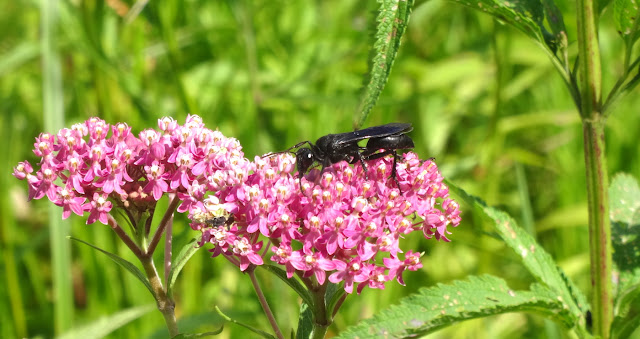7/19/2021
9/03/2020
garden spider
8/30/2020
planthopper
Planthoppers are masters of disguise. A green Acanalonid Planthopper, hiding on a stem, can look like part of the plant -- a seed pod, leaf, bract, or stipule.
This one is only 3/8 inch long. It was perched on a stem at the leaf sheath, probably sucking sap from the grass. Planthoppers, true to their name, can leap many times the length of their bodies. And they are very agile insects that can move easily forwards, backwards, or sideways.
8/28/2020
green frogs on rocks

8/19/2020
black wasp
I was surprised and apprehensive to see this big black wasp on a milkweed flower near the pond. It was alarming because of its size (over one inch) but is not a pest to harm people. This Great Black Wasp Sphex pennsylvanicus, looks iridescent violet-black with smoky transparent wings that have a violet sheen. They visit flowers to feed on nectar and pollen; no harm to the plants.
The female Black Wasp digs a burrow in the ground to reproduce her kind. She hunts katydids, paralyzes them, and places several in the burrow. She then lays eggs in the burrow. They hatch into larvae. They have a ready meal, quietly growing into adult Black Wasps.
7/21/2020
dragonflies for lunch
On 7/18 we thought the Tree Swallows might be ready to leave the nestbox. But they have not fledged yet. The adults are still regularly feeding the three nestlings. And they are bringing bigger food items as the young ones grow. Today both parents kept up a continuous delivery of meals to the nestbox, including several dragonflies. Two little birds were hanging out of the slot above the "door" hoping to get the prize, while the third one was inside the door. The parents feed the young from dawn until dusk, bringing flies, beetles, ants, mayflies, spiders, grasshoppers, damselflies, and dragonflies.
7/13/2020
phoebe nestlings
 We've been watching this one since April as she sits in a tree or on a branch overhanging the pond.
We've been watching this one since April as she sits in a tree or on a branch overhanging the pond.Once she spots an insect, she flies off the branch, snatches the insect mid-air, and returns to the branch to eat it. This is called “hawking”, a behavior shared with other members of the flycatcher family.
Once she started flying under a deck nearby with freshly caught food items, we suspected she was feeding babies.
Sure enough, two small Phoebes peeked out over the edge of the nest.
5/29/2017
bee on cranesbill
While admiring the Cranesbill 'Karmina' in the gardens today, I noticed a fuzzy bee hurrying from one to another of the blooms that are just beginning to open. I believe it is a Carpenter Bee Xylocopa virginica, commonly a nester in various types of wood; they eat pollen and nectar.
9/10/2016
milkweed munchers
One leaf of Common Milkweed was being devoured by both a caterpillar and a beetle. I wonder if either knew the other was there?








